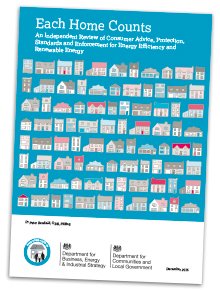Bonfield Review
On 16 December 2016, the long-awaited Bonfield Review, ‘Each Home Counts’ was published.
Originally launched in 2015 by the then-Department of Energy and Climate Change (DECC) in the wake of the failure of the Green Deal, the report has been criticised for numerous delays. The purpose of the review was to examine, and make recommendations, about how consumers can be protected and advised when installing energy efficiency and renewable energy measures in their homes.
There are 27 recommendations included in the review, including:
- There should be a single quality mark for all energy efficiency and renewable energy measures.
- The development of an information hub and data warehouse allowing consumers to access better data relating to their homes, leading to better advice.
- New approaches to engaging with consumers about renewables and energy efficiency through awareness raising at local and national levels.
- Embedding core knowledge into the industry, including building physics, and design stage and consumer interaction connected with the assessment of competence of businesses.
- A robust and joined-up industry-wide compliance and enforcement regime coordinated nationally to include on site monitoring or audits.
In response to the review, Sustainable Homes said:
‘The Quality Mark is a good thing for the industry, but it must have weight. If properly backed by enforcement then it will work. If it leads to quality as in the form of the best Passivhaus schemes then it will work. If it simply becomes a badge for installers to win more work then the Bonfield Review will have been for nothing.’
Brian Berry, Chief Executive of the Federation of Master Builders (FMB), said:
‘The energy efficiency and renewable energy sectors, like the wider domestic building industry, remain largely under-regulated, with too few checks to protect consumers from poor quality builders.
‘The FMB is fully behind the drive for higher levels of consumer confidence …. However, this quality and confidence alone will not be sufficient to drive the quantity of low carbon refurbishment which will be necessary to upgrade the UK’s housings stock and make sure the UK meets its legally binding target by 2050. We also need financial incentives from the Government to encourage home owners to invest in these improvements.’
[edit] Related articles on Designing Buildings Wiki
- Building engineering physics.
- Building Places that Work for Everyone.
- Construction industry reports.
- Eco towns.
- Energy Performance Certificates.
- Government urged to include home energy retrofits in Industrial Strategy.
- Green Deal.
- How to deal with retrofit risks.
- PAS 2035.
- PAS 2038:2021 Retrofitting non-domestic buildings for improved energy efficiency
- Performance gap.
- Retrofit.
- Retrofit coordinator.
- Sustainability.
- The Each Home Counts report and traditional buildings.
- Understanding the performance of solid walls.
- Zero carbon homes.
Featured articles and news
Deputy editor of AT, Tim Fraser, discusses the newly formed society with its current chair, Chris Halligan MCIAT.
Barratt Lo-E passivhaus standard homes planned enmasse
With an initial 728 Lo-E homes across two sites and many more planned for the future.
Government urged to uphold Warm Homes commitment
ECA and industry bodies write to Government concerning its 13.2 billion Warm Homes manifesto commitment.
Places of Worship in Britain and Ireland, 1929-1990. Book review.
The emancipation of women in art.
CIOB Construction Manager of the Year 2025
Just one of the winners at the CIOB Awards 2025.
Call for independent National Grenfell oversight mechanism
MHCLG share findings of Building Safety Inquiry in letter to Secretary of State and Minister for Building Safety.
The Architectural Technology Awards
AT Awards now open for this the sixth decade of CIAT.
50th Golden anniversary ECA Edmundson awards
Deadline for submissions Friday 30 May 2025.
The benefits of precast, off-site foundation systems
Top ten benefits of this notable innovation.
Encouraging individuals to take action saving water at home, work, and in their communities.
Takes a community to support mental health and wellbeing
The why of becoming a Mental Health Instructor explained.
Mental health awareness week 13-18 May
The theme is communities, they can provide a sense of belonging, safety, support in hard times, and a sense purpose.
Mental health support on the rise but workers still struggling
CIOB Understanding Mental Health in the Built Environment 2025 shows.
Design and construction material libraries
Material, sample, product or detail libraries a key component of any architectural design practice.
Construction Products Reform Green Paper and Consultation
Still time to respond as consultation closes on 21 May 2025.
Resilient façade systems for smog reduction in Shanghai
A technical approach using computer simulation and analysis of solar radiation, wind patterns, and ventilation.
























